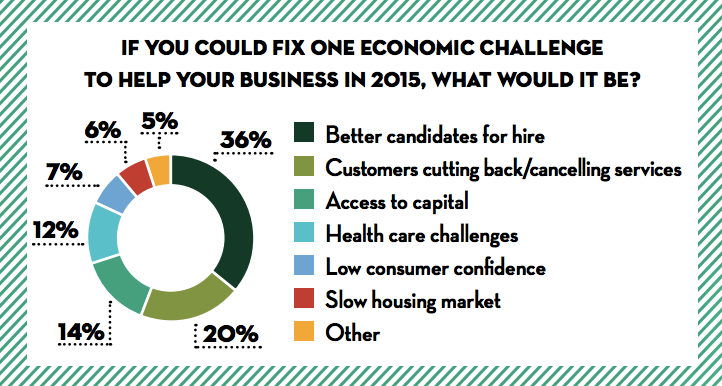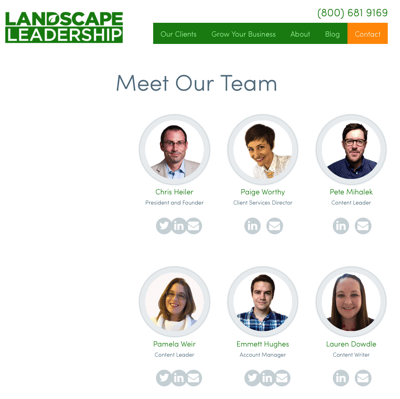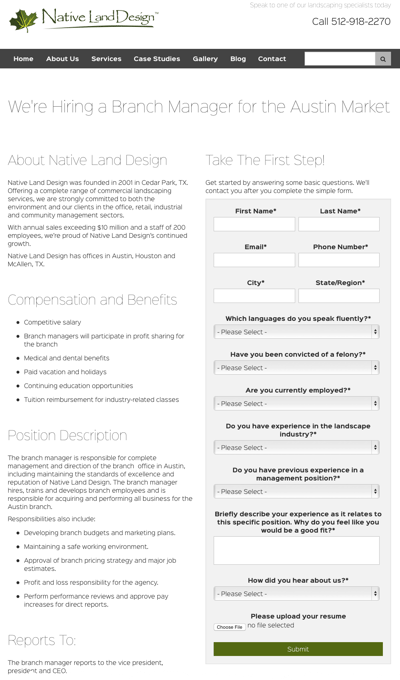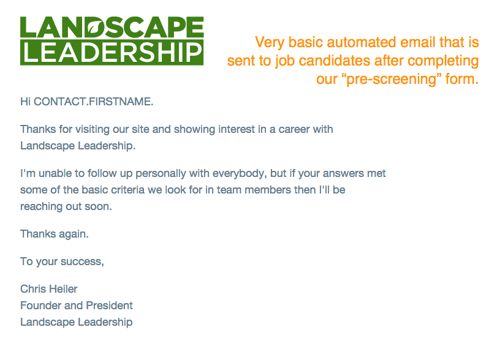Topics: Recruiting
Inbound Recruiting in the Landscaping Industry: 5 Recommendations
 Author: Chris Heiler
Author: Chris Heiler
This article was originally written for Lawn & Landscape magazine and appeared in the Hire Power monthly column in the August 2015 issue.
---
In their 2014 State of the Industry Report, Lawn & Landscape asked readers, “If you could fix one economic challenge to help your business in 2015, what would it be?”. Probably to no one’s surprise, 36% responded, “Better candidates for hire”. This answer outpaced the second and third most popular responses combined.

So, the lawn and landscaping industry has a recruiting problem? I’m sure this comes as a shock to no one. It's tough recruiting in the landscaping industry!
As an industry we make a lot of excuses as to why it is difficult to “find good people”. We tend to point the finger at the job force at large (or at Uncle Sam). Do any of these excuses sound familiar to you?
-
Poor attendance at job fairs and career days.
-
Fewer students in vocational and technical schools.
-
The labor force isn’t “energized” by our industry – it’s beneath them.
-
The younger workforce today just won’t – or cannot – handle the manual labor.
-
Poor leadership in Washington DC and an unstable H-2B program.
I didn’t make these up. I pulled these challenges directly from the 2014 State of the Industry Report.
Let’s take a look in the mirror and be brutally honest with ourselves for a moment: It’s difficult to find good people because most of us stink at recruiting. Let’s take some responsibility in this, shall we?
(RELATED READING: How to Turn Your Website Into a Recruiting Machine [Smarketing Talk Ep. 8])
Following the path of marketing and sales
The way we purchase products and services today has changed greatly compared to just 10 years ago. As consumers we control the sales and buying process more than ever before. This has, in turn, driven companies to adapt (hopefully) and change the way they market and sell their products and services.
The Internet has been at the center of this transformation.
The same applies to how people search for jobs and careers today. They start their search online. Which brings us to this rather large issue:
Our websites stink.
In the lawn and landscaping industry we have a laundry list of why we stink at recruiting.
Your website is the front door to your company’s virtual home. And in our industry, most are about as welcoming as the dilapidated house at the end of the block — you know, the one with the overgrown grass, dangling shutters and flaking paint. Wouldn’t you rather be the cozy home with the perfect lawn and fresh coat of paint?
I’ve said (okay, preached) many times that your website should be your number one salesperson. It should also be your number one recruiter (Notice I didn’t say your only recruiter. It’s one piece of your overall recruiting and hiring machine – but it’s a big one!).
 Here are three reasons to invest in your website from a recruiting perspective:
Here are three reasons to invest in your website from a recruiting perspective:
-
You know what’s not awesome? Employee productivity tanking because they are on the phone answering, “Are you guys hiring?”, or, worse yet, dealing with people walking in off the street asking for an application. I’m not being anti-social here, it’s just that there is a better way. It’s called the Internet. And your website – not your people – should be facilitating this screening process in an automated way.
-
Your website can operate 24/7/365 educating visitors and keeping them abreast of current openings and opportunities in real-time. You can chain an intern to a career fair booth for 24 hours, seven days a week but I don’t suggest it.
-
Connect with candidates and build trust through transparency. That’s a word more of us need to embrace, especially considering the needs of the millennial generation. Be up front on your website about compensation and benefits. Talk about your people, core values and company vision. Don’t be vague and boring like your competitors. As Glassdoor suggests, “If you’re looking for a lower cost-per-hire and more quality candidates, be transparent.”
(RELATED READING: When to Hire a Landscape Salesperson: 5 Steps From 3 Experts)
First step: Put the basics in place on your website
#1: Create a home for career-specific content on your website
A lot of companies are starting to add a “Careers” page to their websites and you should do the same. Make sure this page is prominent. Don’t make candidates dig for it – make it easy to find. See Native Land Design's Careers page as a good example.
At a minimum this page should showcase your current openings and tell candidates how they can apply. Should they fill out a form, call you directly, email you, stop in? Explain the process to them.
This main recruiting page is just a starting point that we will build on in the next four recommendations.
#2: Create secondary content of interest to job candidates
 I mentioned the importance of transparency earlier. This is your opportunity. If a candidate is on your website, trust me, they will dig deep into your site doing their research and determining whether they want to reach out or not.
I mentioned the importance of transparency earlier. This is your opportunity. If a candidate is on your website, trust me, they will dig deep into your site doing their research and determining whether they want to reach out or not.
As an example, the last four job candidates I have interviewed for Landscape Leadership visited our website five times each and viewed 27 pages on average. That is digging deep!
Here are some content ideas that will appeal to candidates:
-
Create a “Team” page featuring your employees. Include images! Candidates want to see who they could potentially be working with. Team pages like this are often the most viewed pages on a website. See our team page as an example.
-
Create content or a blog specifically for recruiting purposes where you share company information and insight. At Landscape Leadership we have a separate “Culture Blog” for this. Keep it light – don’t be corporate boring!
-
Share your core values. Every candidate I talk to mentions how he or she appreciates the way we present our core values on our website for all to see. You can do the same.
Give your candidates a chance to get to know you. Otherwise, like a terrible first date, you’ll never get a second chance.
#3: Maintain up-to-date job openings
 To increase the number of candidates you generate from your website you’ll need to go beyond the basic Careers page. You’ll need to give candidates more information about each position so they understand where they may or may not fit.
To increase the number of candidates you generate from your website you’ll need to go beyond the basic Careers page. You’ll need to give candidates more information about each position so they understand where they may or may not fit.
I suggest creating a unique page for each current job opening with a detailed job description.
Create a page and job description for each role, including administrative and managerial positions as well as field labor positions. Here is a recommended outline you can follow:
-
About your company
-
Position description and responsibilities
-
Compensation and benefits
-
Skills and experience required
-
Who the specific position will report to
For a great example, view Native Land Design’s page for attracting branch managers.
Your recruiting motto should be “Always Be Recruiting”, so keep these pages updated even if you’re not currently hiring for the position. Always be on the lookout for talent.
#4: Use web forms to screen and collect candidate information
Now we’re getting serious, folks. It’s time to take your recruiting machine to the next level and introduce some time-saving automation.
Your company’s website should generate qualified job candidates just as it (should be) generating qualified leads for your sales funnel.
This will require a web form on your career pages. Completing a short web form is painless for a candidate. Asking them to print out your three-page job application and fax it back to you is not. Asking them to email or call you is a waste of your time.
I suggest utilizing a short “pre-screening” form. Only ask for enough information to quickly qualify a candidate and move them to the next step in your recruiting process. Do not require them to complete your entire job application form.
Your website should generate qualified job candidates just as it generates qualified sales leads
This shorter form will convert at a much higher rate because it is less overwhelming and will scare fewer candidates away because you’re not asking for information about their current employer.
Keep in mind, there are two types of job seekers: active and passive. An active job seeker may be willing to complete an extensive application form but the passive job seeker – typically already employed (and most likely your best candidate) – will not. They won’t risk you calling their current employer.
For examples of pre-screening web forms see Native Land Design and Landscape Leadership.
#5: Put a formal follow-up process in place
 Just as you have a formal process for following up with new sales leads, you will also need to create a follow-up process for new job candidates. Let’s assume your company’s website is advertising an opening for a branch manager. Your follow-up process could look something like this:
Just as you have a formal process for following up with new sales leads, you will also need to create a follow-up process for new job candidates. Let’s assume your company’s website is advertising an opening for a branch manager. Your follow-up process could look something like this:
-
When a candidate fills out a web form they are instantly sent an automated “confirmation” email. You can also set expectations by including “next steps” in the process or even requesting they forward their resume.
-
One person within your company should receive an instant notification via email when a job candidate completes a web form.
-
This person should score or grade the candidate as quickly as possible, either moving the candidate to the next step or removing him or her from the process. Grade the candidate using the information in your pre-screening form, by reviewing their resume (if he/she uploaded it) and by reviewing their profile on LinkedIn. You can grade using a number scale or a “A, B, or C” scale. I like using a star rating scale. If a candidate is a four or five star they move to the next step. If not, they go no further.
-
Move the qualified candidate on to the next step in your recruiting and hiring process within 24 to 48 hours. Maybe you send them your full job application to complete. Maybe you schedule an in-person interview. Or maybe it’s a phone interview.
This follow-up process will look a bit different for every company. The point is to have a process in place that quickly qualifies or disqualifies candidates generated through your company’s website and efficiently moves them to the next hiring stage.
Wrap up
It's tough recruiting in the landscaping industry. I acknowledge we are faced with very real challenges when it comes to “finding good people” for our companies. However, let’s stop shooting ourselves in the foot and making it more difficult by ignoring the front door to our company’s virtual home.
Let’s be more proactive as recruiters. We can start by elevating the importance of our website. Start with these five basic recommendations and your company’s website will soon be attracting qualified job candidates instead of scaring them away.
If you want more recruiting insight then subscribe to our blog and receive one new article each week. Just add your email address below. Be sure to register for the teleseminar I'm doing with Jeffrey Scott Wednesday September 16. We'll be talking all about how to recruit and retain top talent.
Image credits: 24-hour sign




